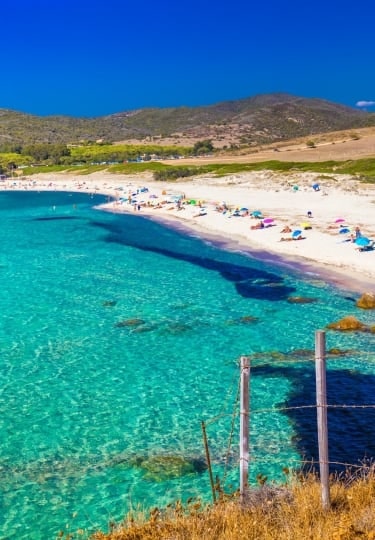Indented by some 200 beaches, bays and coves, Corsica’s 620 miles of rugged coastline is a joy to explore. You’ll find sand that ranges from dazzling, powdery white to dusky pink and even sparkling black. Corsica’s beaches are often framed by pink granite rocks and backed by forests of bottle-green umbrella pines. The scent of the maquis—the aromatic wild flowers and herbs that Corsicans claim is unique to their island—is always present.
Some Corsica beaches offer chic restaurants and an array of watersports, while others are completely deserted, or at most, feature a single paillote, a toes-in-the-sand, seasonal beach restaurant. Here are 16 of the best beaches in Corsica, which are all accessible from Ajaccio as a day trip.
St. François Beach, Ajaccio
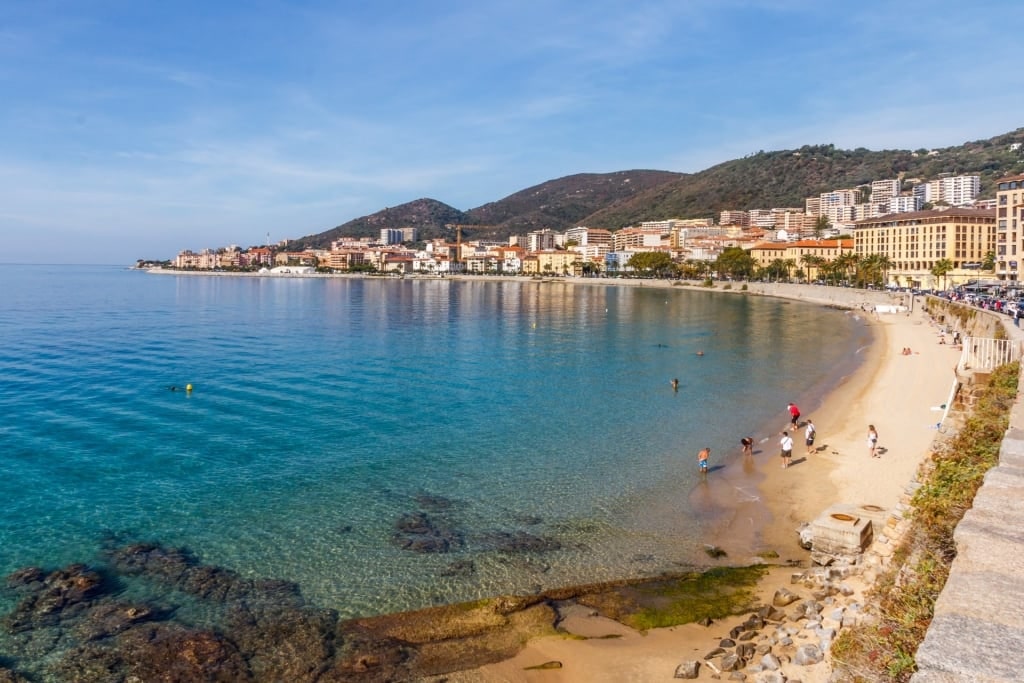
St. François Beach, Ajaccio
St. François is Ajaccio’s cool, urban beach right in the center of the city, stretching between the bastions and the 15th-century citadel. Visiting here is one of the best things to do in Corsica, as the narrow strip of sand shelves gently into warm, clear sea, safe for swimmers of all abilities.
A promenade runs the length of the beach lined with cafes and restaurants. It’s always busy with locals and visitors out for a stroll. The biggest bonus of St. François is its easy access to the city, making it the perfect spot to take a cooling dip after a busy day of sightseeing.
The birthplace of Napoleon Bonaparte is the principal attraction of Ajaccio, but the town itself is a delight. Chic cafes, pastel-colored mansions, palm-lined boulevards, and a tangle of narrow streets of the old town spread out from Place Foch.
Ricanto Beach, Ajaccio
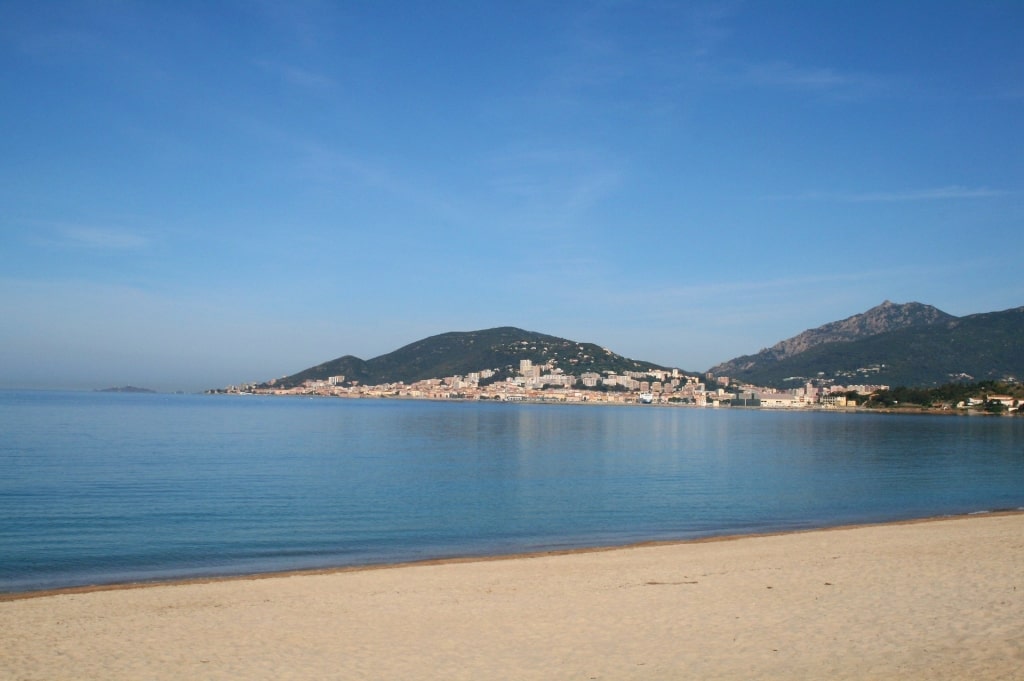
Ricanto Beach, Ajaccio by Jean-Pol GRANDMONT CC BY 3.0
Just east of Ajaccio, with fine views of the bay, the gently sloping Ricanto Beach stretches for a mile and a half. For a city beach, it’s surprisingly undeveloped. Ricanto is a blissfully uncrowded option for safe swimming within easy reach of the heart of Ajaccio.
The runway of Ajaccio’s airport is perpendicular to the coastline, so you may get some close-up views of landing and taking off aircraft while lounging on this Corsica beach. At the top end, the Tahiti Beach Café, a relaxed paillote or beach shack, does salads, pasta, fresh fish, crêpes, gelato, and cocktails. You can rent an umbrella and lounger here, too.
Stagnone Beach, Calcatoggio
With a car, or by taxi, the Plage du Stagnone is a thrilling drive north from Ajaccio across the coastal mountains, along winding roads and through tiny, time-forgotten villages. One of the loveliest of Corsica’s beaches, Stagnone is a long arc of powdery white sand with plenty of facilities, including jetskiing and parasailing.
For lunch, stop by Le Malibu right on the beach for casual outdoor dining. Pizzas, the house tiramisu, and—for the non-driver—shots of Limoncello are all specialties.
Liamone Beach
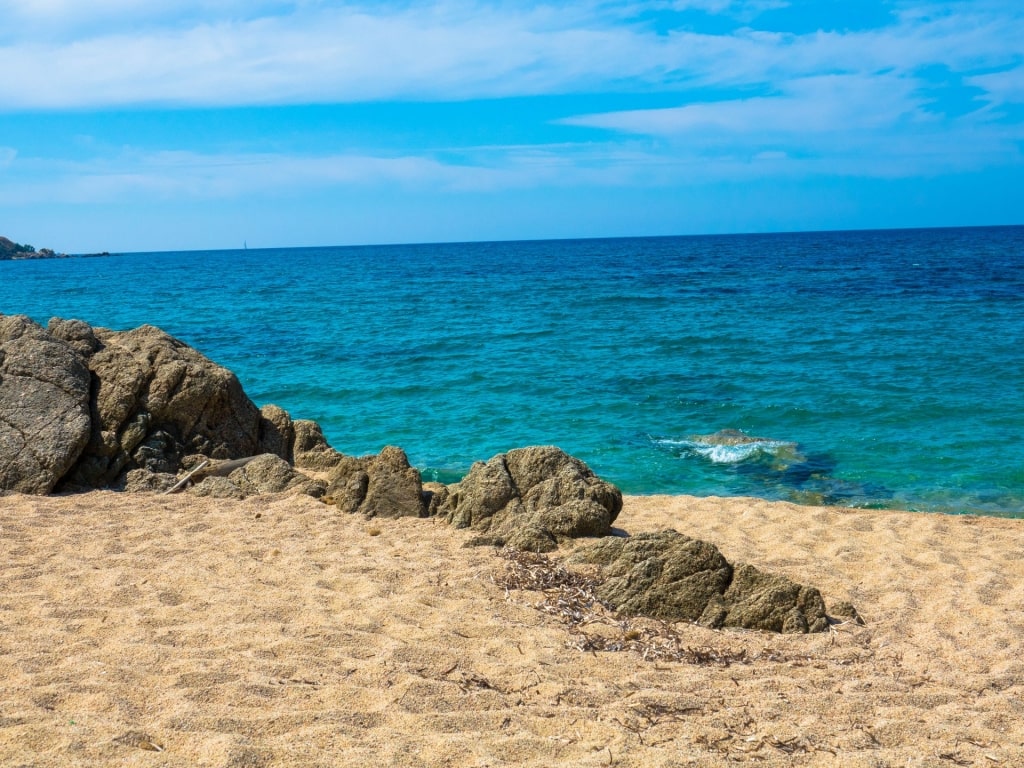
Liamone Beach
Wild and beautiful, Liamone Beach is a huge sweep of coarse sand that slopes steeply into an indigo sea. The surf and currents can be strong on Liamone Beach, but the mouth of Liamone River, blocked from the sea by a sandbar, is calm and shallow. It’s banks lined with reed beds, the river is perfect for kayaking and stand-up paddleboarding.
Further north, beyond Stagnone, Liamone has fewer facilities than its neighbor, although you’ll find a couple of restaurants in which to refuel, like Le Liamone Beach restaurant.
Calanques de Piana, Piana
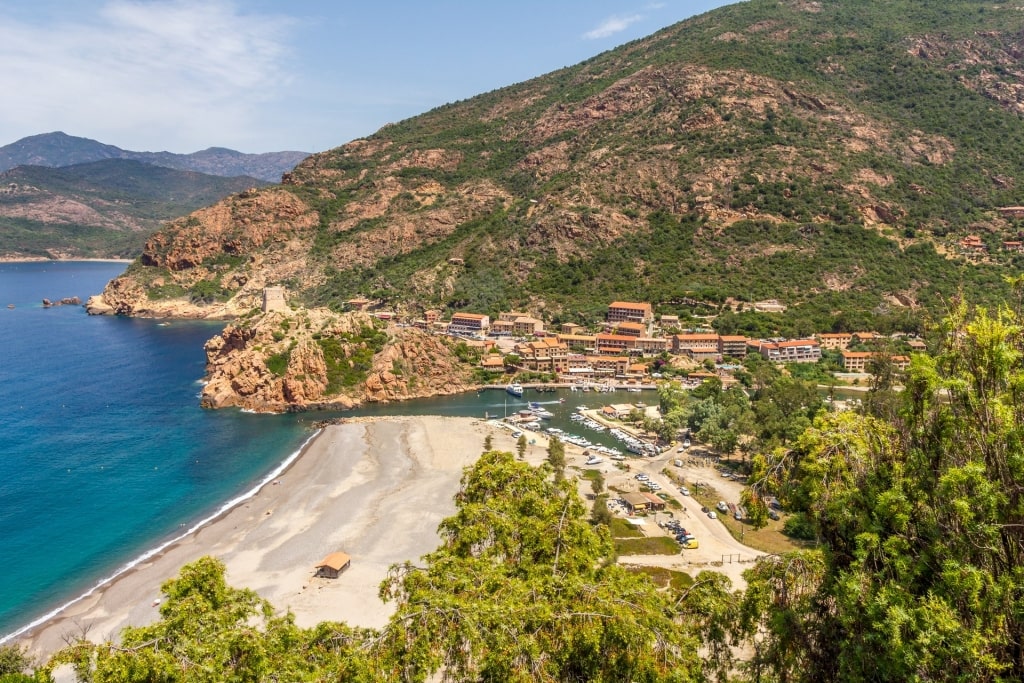
Calanques de Piana, Piana
Not a beach as such but some of the most dramatic coastal scenery you’ll see in the Mediterranean, the Calanques de Piana, a UNESCO World Heritage Site north of Ajaccio, is a series of sheer, rose pink and ochre granitic cliffs plunging into impossibly turquoise water, rock arches, caves and pinnacles shaped by wind and waves.
Visiting requires a full-day trip from Ajaccio, but it’s worth it. The road here is sinuous and narrow, and the views seductive. Keep driving until you reach the iconic Chalet des Roches Bleues, situated high in a ravine. Stop for a drink on the terrace and admire the dramatic views down over the coastline.
You can have fun identifying the rocks, which have names like La Tortue (the turtle) and L’Aigle (the eagle). For swimming, carry on to the pebbly Ficajola Beach, which is surrounded by pink cliffs and shimmering aquamarine waters.
Plage de Porticcio, Porticcio
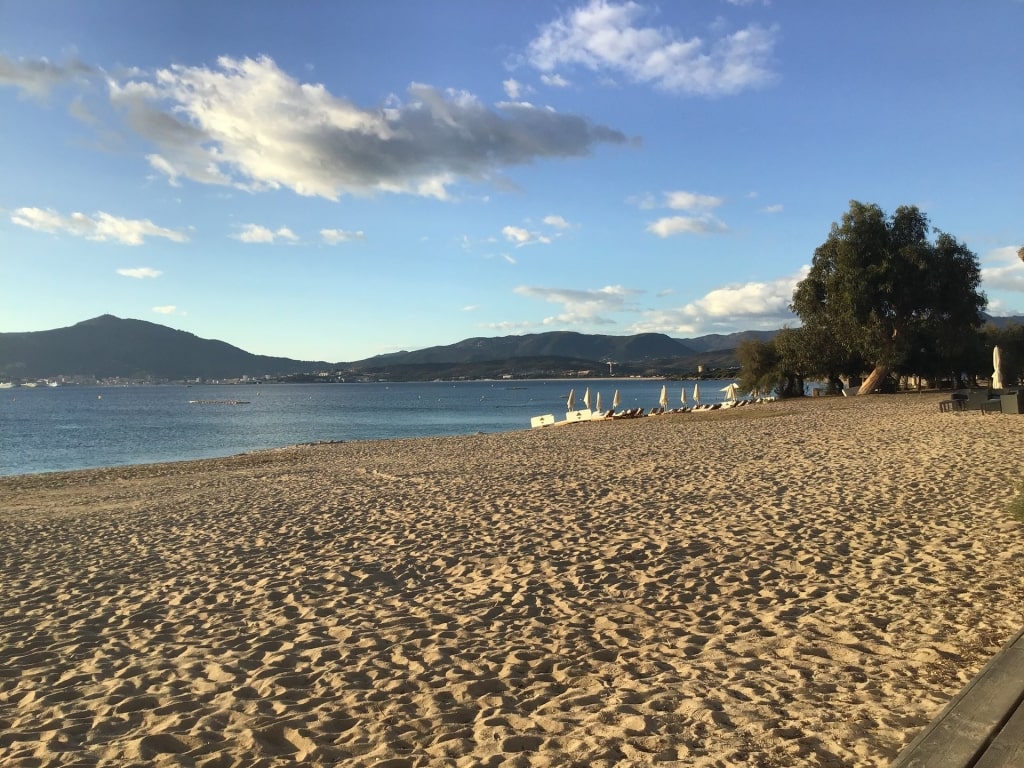
Plage de Porticcio, Porticcio
Heading south from Ajaccio and easily accessible by road or a 20-minute ferry ride across the bay, Porticcio is a fashionable resort fronted by a long sweep of golden sand and backed by wooded hills. In spring, you may still see snow on distant mountains from here.
The main stretch of beach to the north is called Plage de la Viva and has everything you’ll need, from loungers to watersports and beach bars. Further south, towards the Pointe de Porticcio, a necklace of smaller, more secluded Corsica beaches circles the headland.
Plage d’Agosta, Porticcio
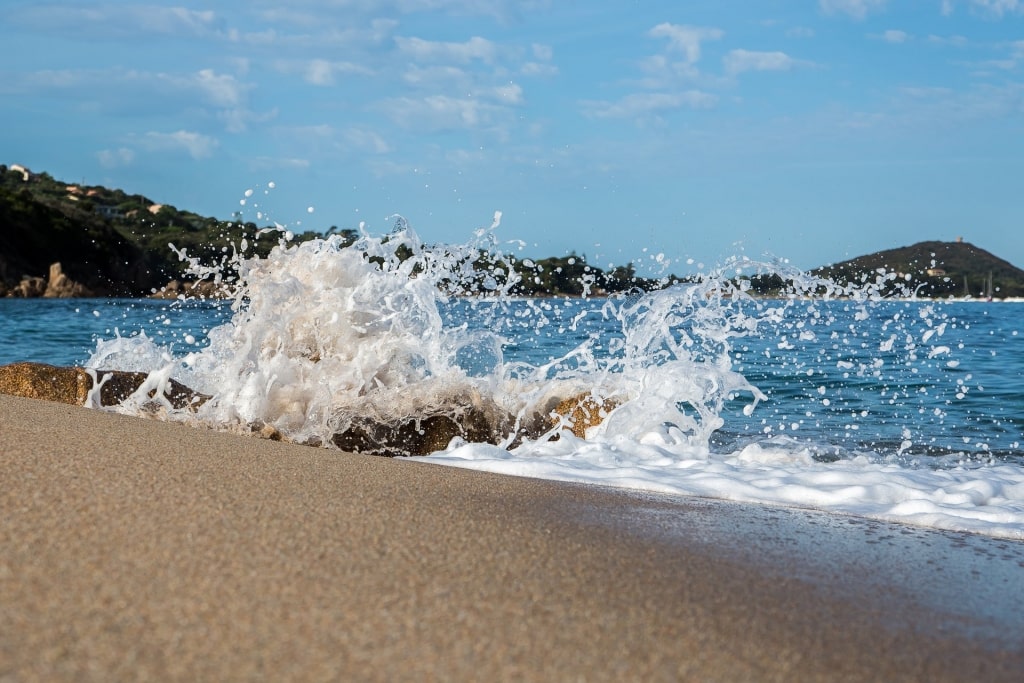
Plage d’Agosta, Porticcio
The southern section of Porticcio town sits at the top end of the long, sandy Plage d’Agosta. The sea bed shelves more steeply here, so if you’re traveling with small children, stay on Plage de la Viva.
Agosta, though, is great for diving, with a dive center on the beach as well as other adrenaline-boosting activities, from parasailing to banana boats and donuts. You’ll find several restaurants, but the paillotes are the most fun for local-style casual dining.
Isolella Beach, Isolella Peninsula
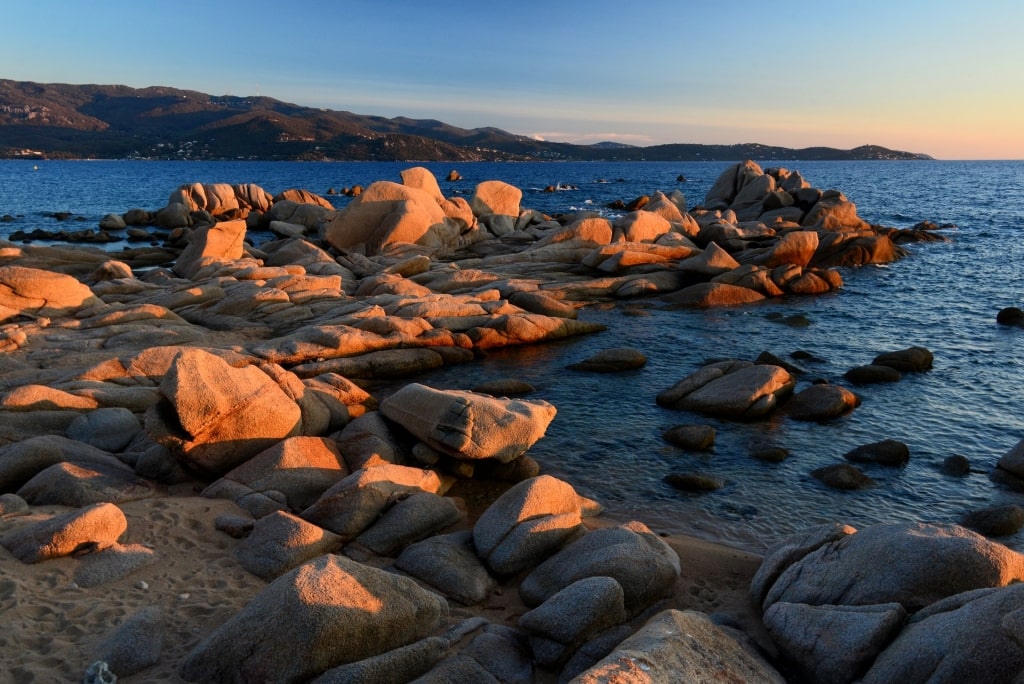
Isolella Beach, Isolella Peninsula
A bijou strip of white sand fringed by red-gold, wave-sculpted rocks, Isolella is one of the best Corsica beaches within easy reach of Ajaccio. It’s just south of Porticcio and features views across the bay to the citadel.
The beach itself is right on the tip of the craggy Isolella peninsula and guarded by a restored, 17th-century Genoese watchtower which you can reach via a short, rocky trail for magnificent views.
There’s good snorkeling at Isolella, as the seabed is mainly rocky. This is a remote spot, though, with little in the way of amenities, so bring water and a picnic. You can buy fougasse, the local flatbread, and brocciu, a cheese made of ewe’s milk, and fat, juicy peaches at any store for the perfect beach feast.
Anse Medea Beach, Isolella Peninsula

Anse Medea Beach, Isolella Peninsula
On the southern shore of the Isolella peninsula, Anse Medea is a popular anchorage for visiting yachts. The attraction of this pretty little cove is the fact that the sand is actually pale pink, a pleasing contrast with the dense greenery that fringes the shoreline.
The seabed here is rocky and sandy and the water crystal clear, so there are good snorkeling opportunities. You won’t find anywhere to eat on the beach itself but there are supermarkets near the parking lot where you can easily assemble a picnic lunch.
Le Ruppione, Pietrosella
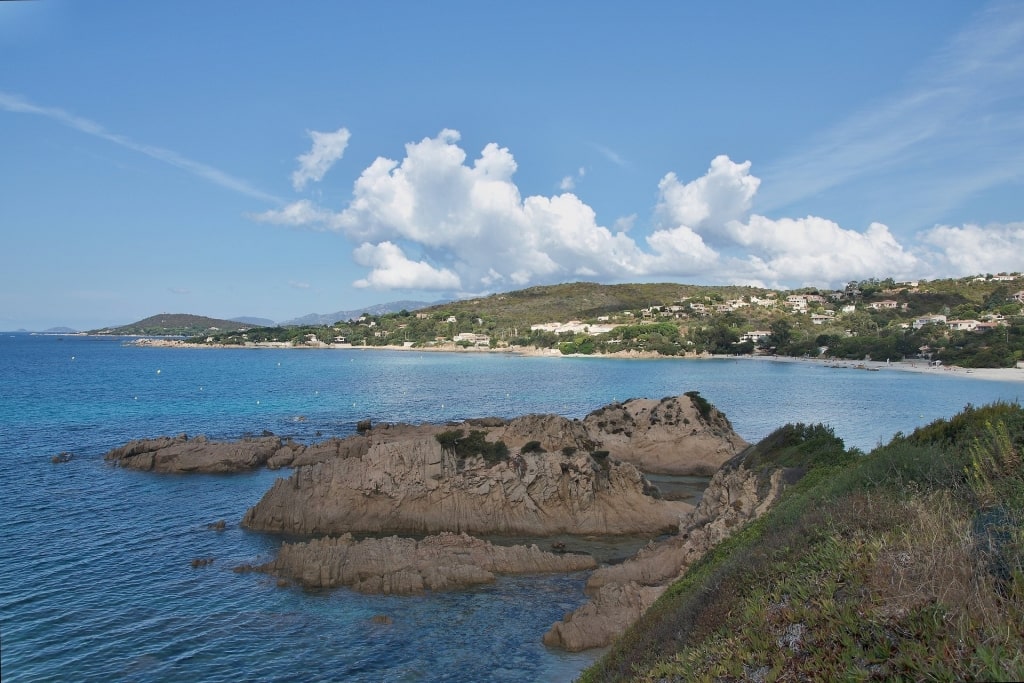
Le Ruppione, Pietrosella
Ruppione is a serene beach resort south of Isolella. Villas and vacation homes stretch back from a half moon of white sand backed by green hills, big rocks tumbled at either end of the beach.
The wind can pick up here, so you’ll see windsurfers zipping across the bay, although close to the shore, the water is usually calm. The beach is supervised by lifeguards in the summer months, and there are plenty of facilities.
A couple of restaurants keep hungry diners happy. The Paillote de Ruppione, with wooden bench seating in the dappled shade of a canopy, offers seafood and snacks. It’s a stone’s throw from the water and the perfect spot to wash down lunch with an ice-cold glass of rosé.
Read: The Ultimate Corsican Food Guide
La Plage d’Argent, Coti-Chiavari
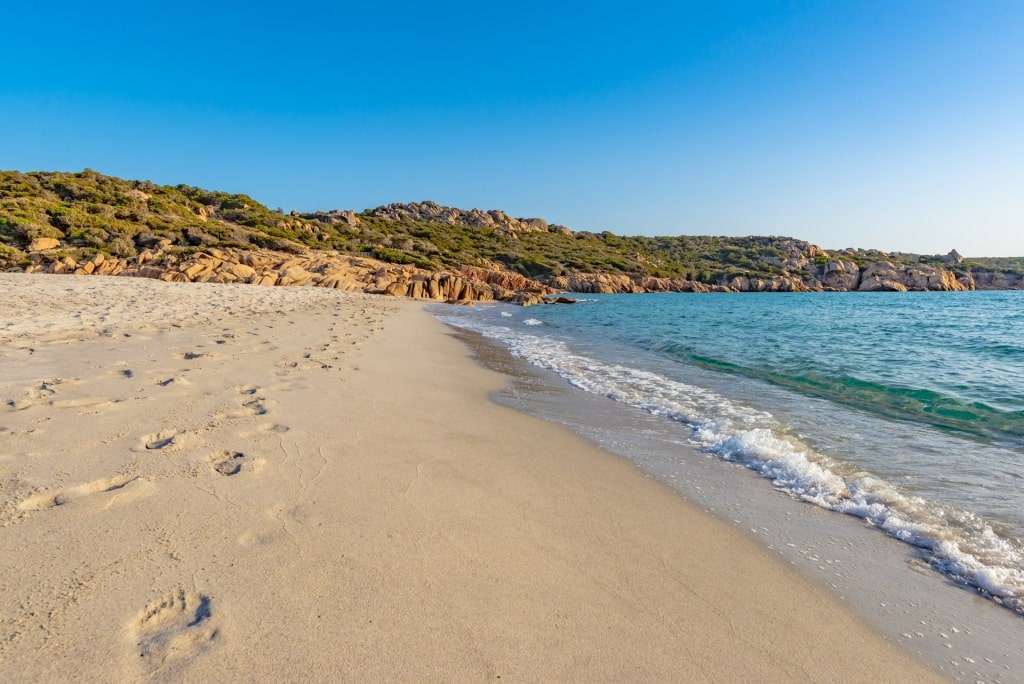
La Plage d’Argent, Coti-Chiavari
As its name suggests, Silver Beach, also known as Mare E Sole, is absolutely gorgeous. One of the best beaches in Corsica, this long sweep of silvery white sand slopes gently into azure shallows, with red-gold rocks at either end and the scent of nearby pine forests in the air.
There’s no residential or tourism development, so you can enjoy a real sense of wilderness, although the beach is accessible by road and is popular with visiting yachts. Retreat to the shade of the pine forest for a picnic or enjoy fine dining, Corsican style, at Le Plage d’Argent. The shaded wooden deck overlooks the beach, and the menu features dishes like swordfish tartare, steak and chips, and shrimps flambéed in rum.
Plage de Cupabia, Coti-Chiavari
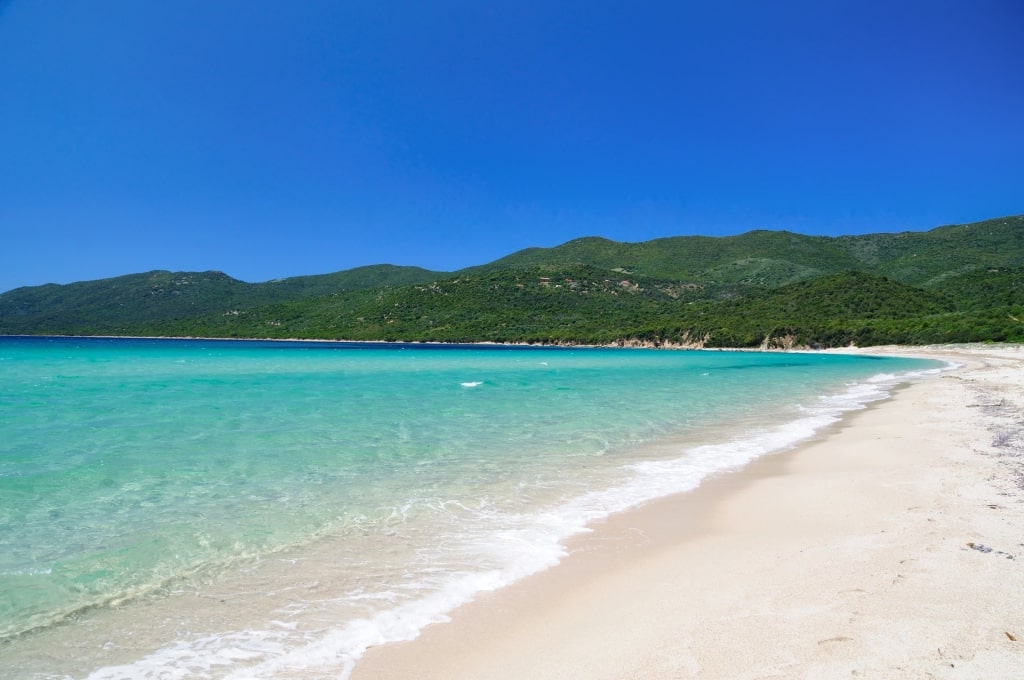
Plage de Cupabia, Coti-Chiavari
Three consecutive bays of bleached white sand and translucent water, the scent of herbs on the breeze, Plage de Cupabia is blissfully quiet most of the year. A campsite and a beach bar are among its only facilities. The clarity of the water here is exceptional, and Cupabia is a popular spot for divers as underwater pinnacles rise as close as 30 feet from the surface.
The greatest appeal of this beach, though, is the fact that you’re really out in the middle of nowhere, with just pines and shrubs behind the beach. As the sand narrows into rocks at the southern end, a trail leads up through the pines and along a pristine stretch of coast for gorgeous views and a chance to stretch your legs.
Roccapina Beach, Sartene
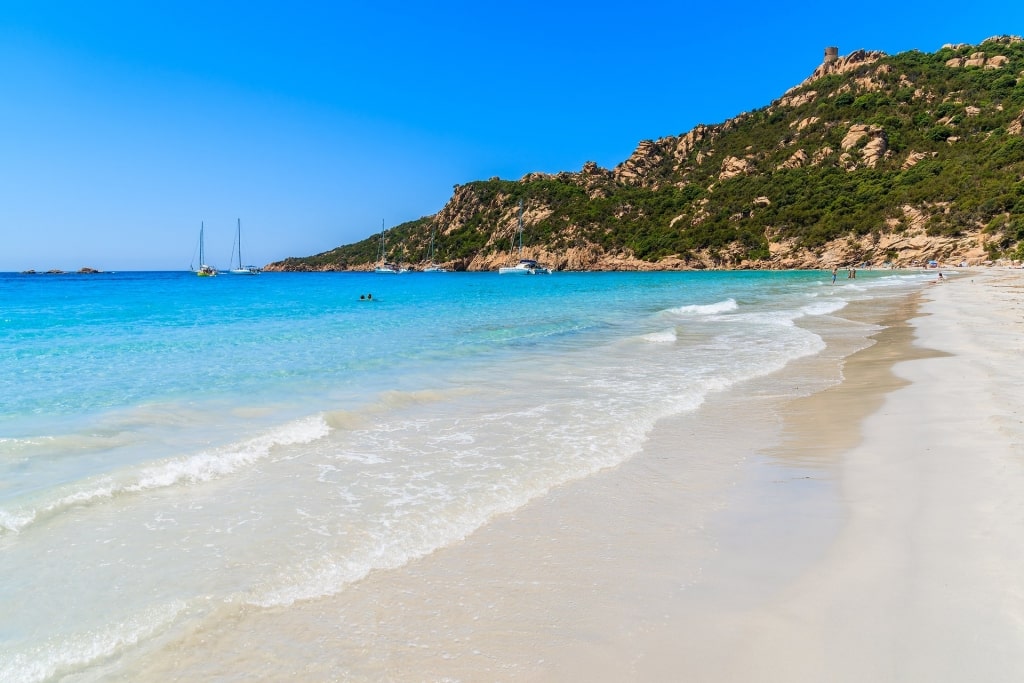
Roccapina Beach, Sartene
The spectacular Roccapina Beach, south of Sartene, is some distance from Ajaccio. On Corsica, however, the journey is all part of the fun. The road to Roccapina Beach includes two hours of scenic driving along clifftop roads and over pine-clad mountains.
The beach, a sheltered, turquoise cove, is framed by massive pink granite rocks. One, Le Lion de Roccapina, on top of the cliff and sculpted by wind, resembles a vast, crouching lion, hence the name. In front of the lion, the chunky Tour du Lion de Roccapina has guarded the coast against pirate attacks for centuries.
If time permits, follow the rocky trail up over the headland. The views are magnificent, and the path takes you down the other side to the vast expanse of Erbaju Beach, which is backed by low dunes.
You could also hunt for treasure; local legend says that the rocks above the beach conceal Indian gemstones. The steamer Tasmania ran aground near here in 1887, shedding a cargo of precious stones being transported from wealthy Indian Maharajas to Britain’s Queen Victoria. Corsican bandits gathered the stones, some of which are believed to be hidden to this day.
Grand Capo di Feno and St-Antoine, Ajaccio
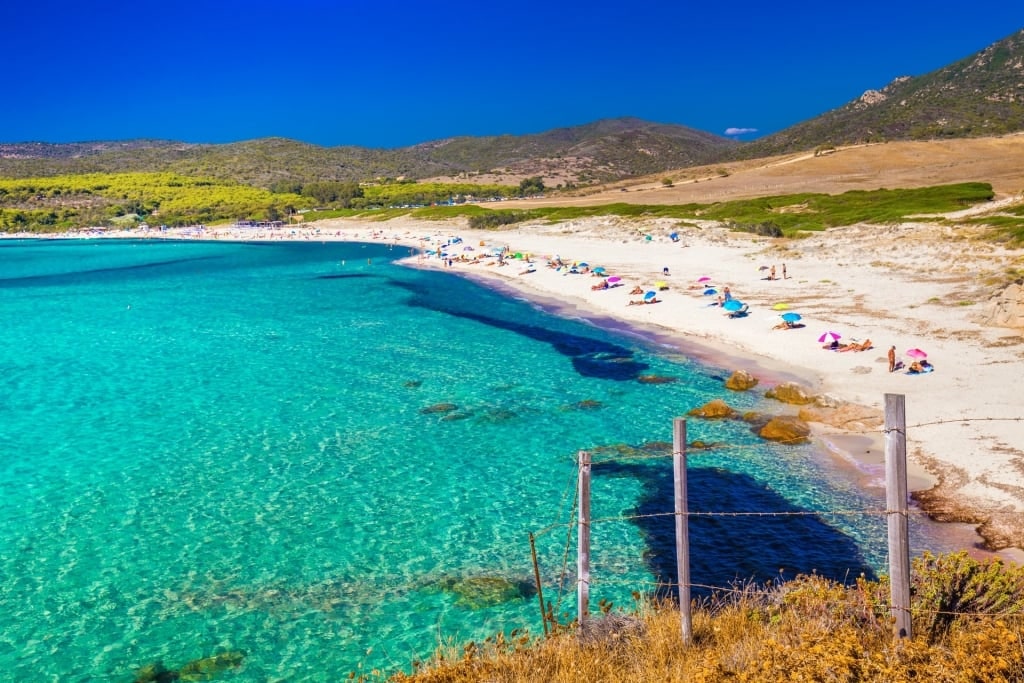
Grand Capo di Feno and St-Antoine, Ajaccio
Two of the finest Corsica beaches within easy reach of Ajaccio, Grand Capo di Feno and its smaller neighbor, St-Antoine, are your reward after hiking the scenic trails of the Parata Peninsula. Stroll along the top of cliffs of black granite, the scent of the maquis always in the air, the sparkling Mediterranean beneath you, with views of the four, red-rock Iles Sanguinaires in the distance.
You could, of course, skip the hike and head straight to the beaches. Popular with surfers, Grand Capo is a wide stretch of sand sloping into the brilliant turquoise sea. St-Antoine, across the headland and accessed by a short trail, is much smaller.
Both beaches have an assortment of cafes and paillotes; try Little Capo, a chic little restaurant on St-Antoine, with lovely views over the waves.
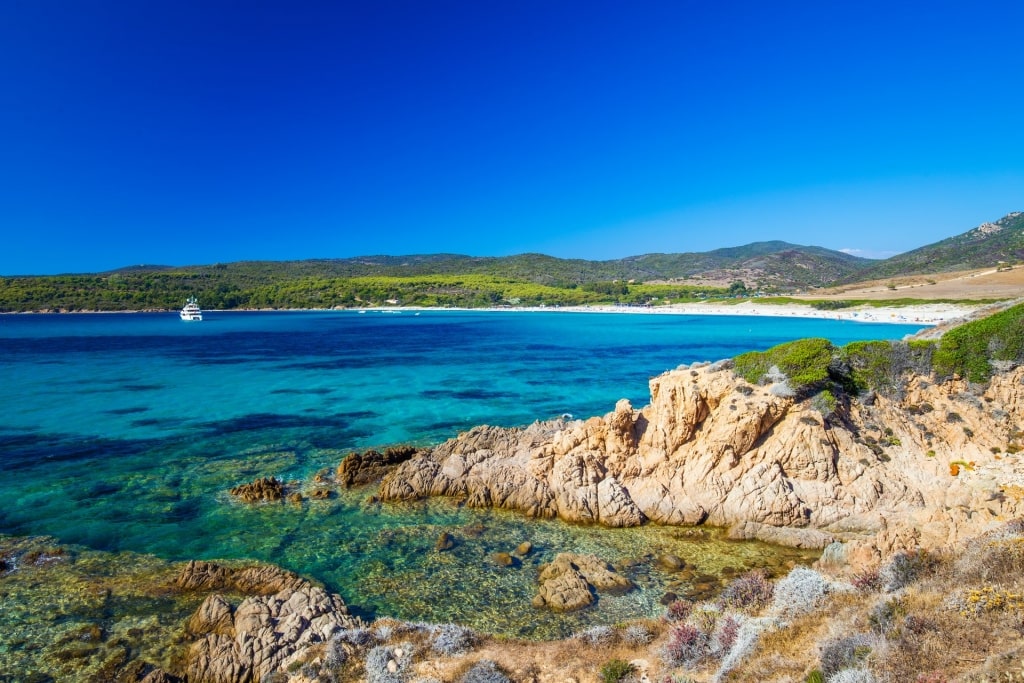
Grand Capo di Feno and St-Antoine, Ajaccio
La Terre Sacrée, Ajaccio
Head west out of Ajaccio on the Sanguinaires road and you’ll find beaches strung along the Parata Peninsula with steep hills behind. From the point of the peninsula, you’ll have magnificent views of the protected Iles Sanguinaires, four hilly islets of blood-red porphyry rock guarded by a lighthouse.
La Terre Sacrée is one of the best beaches in Corsica, where a strip of fine sand is framed by pink granite rocks, the water an inviting aquamarine.
Take time to visit the poignant 1914-18 war memorial erected in 1933 in honor of the Corsicans who gave their lives in the First World War. Earth from 12 different battlefields is kept inside the modest monument, which sits right on the beach.
Le Palm Beach, Ajaccio
Another great swimming spot along the Sanguinaires road heading west out of town is the white crescent of Le Palm Beach, sometimes called Marinella Beach. It was immortalized in the 1930s by French crooner and actor Tino Rossi, whose much-visited grave is at the nearby cemetery.
Fine, white sand, aquamarine water, and the bottle green of the wooded hills create a pleasing color palette. The shallow gradient of the seabed makes this a popular choice for those traveling Europe with kids.
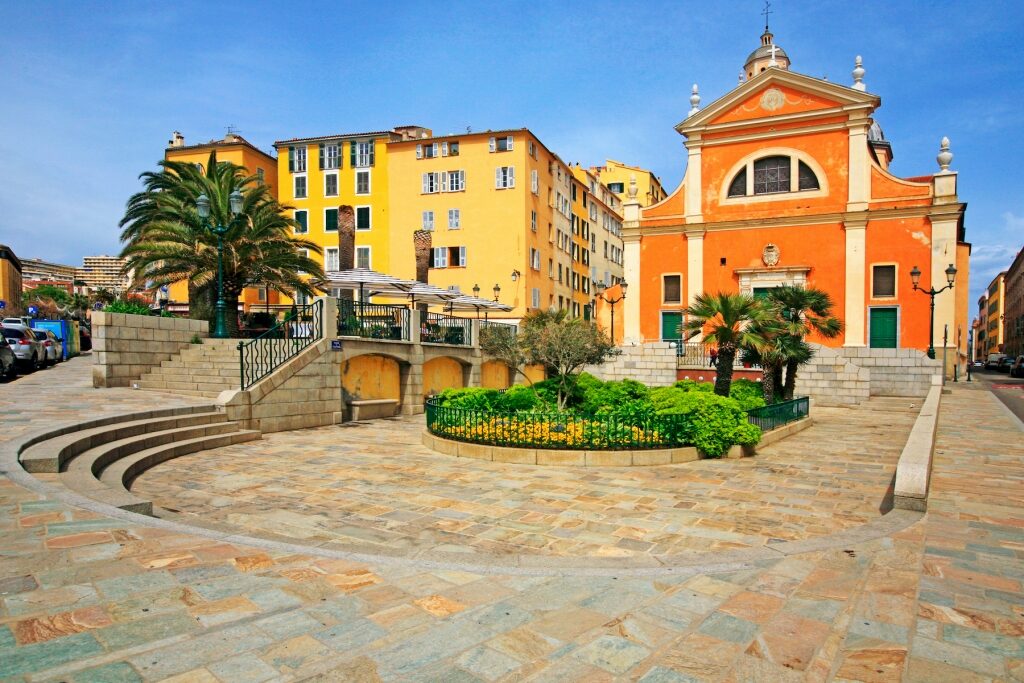
Ajaccio, Corsica
Discover Corsica’s magnificent coastline on a cruise. Browse our range of exciting Mediterranean cruises on our website and book your next unforgettable vacation today.
